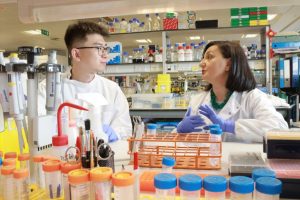Key Takeaways
- Scientists are developing methods to grow real biological teeth in labs.
- A breakthrough hydrogel scaffold improves the environment for tooth growth.
- Multiple global research teams are advancing different techniques.
- Biological teeth could replace dental implants within the next decade.
Researchers worldwide are making significant progress toward growing human teeth in laboratory settings, potentially revolutionizing dental care. A recent breakthrough from King’s College London brings this futuristic concept closer to reality.
The Scaffold Breakthrough
At King’s College London, Ana Angelova Volponi has pioneered lab-grown tooth research for nearly twenty years. Her team recently developed a hydrogel scaffold that better mimics the natural tooth-growing environment in the mouth.
“It’s almost like a tripod,” Volponi explained. “The two types of cells are engaging in tooth making, in a sort of conversation, and then we have the environment where this happens.”
Xuechen Zhang, a doctoral student and study co-author, detailed the process: “We gather the cells first from the mouse embryos and then mix them together and spin them down to get a small cell pellet. Then we inject this cell pellet inside the hydrogel and grow it for around eight days.”
Implementation Approaches
Volponi envisions two potential methods for integrating lab-grown teeth into dentistry. The first involves growing teeth to a certain development stage before embedding them into tooth sockets. The second approach would fully grow teeth before surgical implantation.
“It’s still too early to say which approach will be more viable,” she noted.
Advantages Over Traditional Implants
Biological replacement teeth grown from patients’ own cells offer significant benefits:
- No inflammation or tissue rejection
- Natural feeling and elasticity
- Integration with bone and ligament structures
Traditional implants lack sensation and simply fuse into bone, making biological alternatives superior for patient comfort and function.
Global Research Efforts
Multiple research teams are pursuing different approaches to tooth regeneration:
In Japan, Katsu Takahashi’s team at Medical Research Institute Kitano Hospital is developing an antibody-based treatment for congenital tooth absence. This treatment has entered human clinical trials and could be available by 2030.
At Tufts University, Pamela Yelick’s team grew human-like teeth from human and pig cells in pigs during late 2024. The ultimate goal is prompting human jaw cells to grow new teeth without pig cells.
University of Washington researchers, led by Hannele Ruohola-Baker, are growing dental pulp stem cells from donated wisdom teeth. “We aim to uncover the molecular blueprint of human tooth formation and to recreate that process in the laboratory,” she said.
Timeline for Clinical Application
According to Ruohola-Baker, biological tooth repair or replacement could become a realistic option within the coming decade. “Although clinical translation will take time, momentum in this field is accelerating,” she confirmed.
Vitor C. M. Neves from the University of Sheffield praised Volponi’s pioneering work: “Her new research tackles a key factor in the production and potential industrialization of this technology. The more researchers who contribute to advancing this field, the sooner humanity will be able to reap its benefits.”





